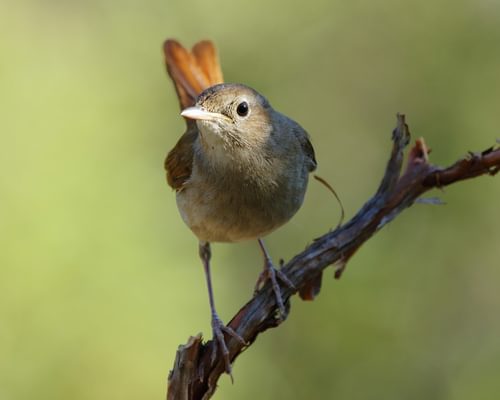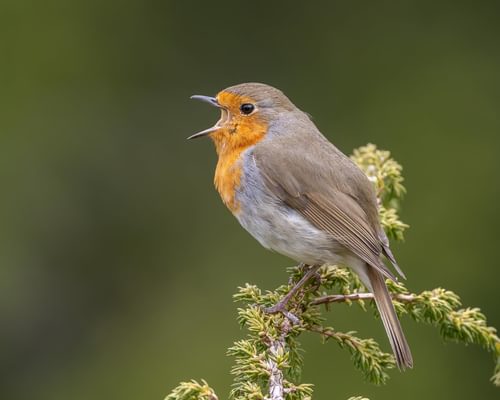Bluethroat
Least ConcernLuscinia svecica
Visual Identification
Appearance
The Bluethroat is a small, robin-sized bird with a distinctive appearance. Males have brilliant blue throats and breasts, bordered by bands of black, white, and rusty orange. The upperparts are brown, contrasting with a white eyebrow and reddish tail sides.
Females lack the blue throat. Instead, they have a pale throat and breast with dark spotting. Juveniles are similar to females but with additional spotting on the upperparts.
Size
Length
13cm to 14cm
Wingspan
20cm to 22cm
Weight
16g to 22g
Habitat and Distribution
Habitats
Woodland
Garden
Wetland
Coastal
Urban
Farmland
Grassland
Desert
Tundra
Rainforest
Mountain
Savanna
Distribution
Bluethroats inhabit a wide range of moist habitats, including Arctic tundra, wetlands, and alpine meadows. During the breeding season, they're found across northern Europe and Asia, extending into Alaska.
In winter, they migrate to southern Europe, Africa, and southern Asia. They're rare visitors in the UK, mainly seen during spring and autumn migrations along the east coast.
Elevation Range
Sea level to 2,000 meters
Climate zones
Subarctic, Temperate, Continental
Distribution Map
This map gives you a rough idea of where you might spot a Bluethroat. The coloured areas show countries where these birds have been seen.
A few things to keep in mind:
- Birds might not be everywhere in the coloured areas, for example, they may be present around the coast of that country
- Where birds live can change with seasons and available food
- This map is quite simple - it doesn't show exact locations
We're working on making our maps even better! Soon, we hope to show you:
- More detailed maps for bigger countries, including state and region
- How birds move around during different seasons
Distribution by Region
Behaviour and Ecology
Bird Attributes
This feature is in beta. We'd love your feedback to improve it!
Share your thoughtsBird Attributes Explained
Our bird attributes system rates various aspects of a bird's capabilities on a scale of 0-100, based on data from field observations, scientific studies, and expert knowledge.
Attribute Categories:
- Agility: Manoeuvrability, speed, and grace in flight or movement.
- Strength: Physical power, often correlating with size and hunting abilities.
- Adaptability: Ability to thrive in various environments or changing conditions.
- Aggressiveness: Territorial behaviour and assertiveness, particularly during breeding seasons.
- Endurance: Stamina, often seen in migration patterns or foraging behaviours.
Understanding the Ratings:
- 0-20: Very Low
- 21-40: Low
- 41-60: Average
- 61-80: High
- 81-100: Very High
Remember, these attributes are relative to other bird species and don't necessarily indicate superiority.
Hover over the icon next to each attribute for more information.
Tap the icon next to each attribute for more information.
Agility
Reflects the bird's manoeuvrability, speed, and grace in flight or movement.
The Bluethroat demonstrates remarkable agility, with its quick, darting movements whilst foraging and its ability to navigate through dense vegetation. Its elaborate flight displays during breeding season further showcase its nimble aerial prowess.
Strength
Indicates the bird's physical power, often correlating with size and hunting abilities.
As a small songbird weighing between 16-22 grams, the Bluethroat possesses limited strength relative to larger birds. However, it's robust enough to undertake long-distance migrations and defend its territory.
Adaptability
Represents the bird's ability to thrive in various environments or changing conditions.
Bluethroats exhibit exceptional adaptability, thriving in diverse habitats from Arctic tundra to alpine meadows, and at elevations from sea level to 5000 metres. Their ability to navigate long-distance migrations and adjust to varied environments is truly impressive.
Aggressiveness
Measures the bird's territorial behaviour and assertiveness, particularly during breeding seasons.
While not overtly aggressive, male Bluethroats vigorously defend their territories during breeding season, engaging in elaborate displays and persistent singing. Their secretive nature suggests a generally non-confrontational disposition outside of breeding periods.
Endurance
Reflects the bird's stamina, often seen in migration patterns or foraging behaviours.
The Bluethroat's endurance is evidenced by its long-distance migratory behaviour, travelling between Arctic breeding grounds and southern wintering areas. This journey, coupled with their ability to survive in harsh Arctic conditions, demonstrates remarkable stamina for a small bird.
Diet
Bluethroats are primarily insectivorous, feeding on various small invertebrates, including beetles, flies, and spiders. They also consume small berries and seeds, especially during migration and in winter.
Their foraging style involves quick, darting movements on the ground.
Behaviour
Bluethroats are known for their secretive nature. They often skulk in dense vegetation. They forage on the ground, darting quickly between cover.
During the breeding season, males perform elaborate flight displays, singing vigorously to attract mates and defend territories.
Vocalisation
The Bluethroat's song is a varied, melodious warble, often incorporating mimicry of other bird species. Their call is a sharp, metallic 'tack' or 'chack'.
During courtship, males produce a distinctive buzzing 'bzeee' sound as part of their display.
Nesting & Breeding
Bluethroat breeding season typically begins in late spring. Males establish territories and attract females with elaborate song flights and displays.
Nests are built on or near the ground, well hidden in dense vegetation. The cup-shaped nest is constructed of grass, leaves, and moss. Females lay 4-6 pale blue-green eggs with reddish-brown speckles.
Incubation lasts about 13-14 days, primarily by the female. Both parents feed the nestlings, which fledge after 13-14 days. Pairs often raise two broods per season in favourable conditions.
Lifespan
The Bluethroat typically lives for 3 to 5 years, with a maximum recorded lifespan of 11.4 years.
Like all birds, lifespan can be affected by factors including predation, habitat quality, disease, and access to food sources.
Conservation and Status
Global Conservation Status
While currently listed as Least Concern globally, Bluethroats face localised threats from habitat loss and climate change. Conservation efforts focus on protecting wetland breeding habitats and stopover sites along migration routes.
Birdwatching Tips
- Look for Bluethroats in wetland edges and dense scrub
- Listen for their varied, melodious song, especially at dawn and dusk
- Be patient and quiet; they often reveal themselves briefly before ducking back into cover
- In the UK, coastal reed beds in East Anglia are good spots during migration
Additional Information
Quick Facts
Other names:
Arctic Bluethroat, Red-spotted Bluethroat, Cyanecula svecica
Family:
MuscicapidaePredators
Did You Know?
- Bluethroats can mimic the calls of up to 40 different bird species.
- They have been known to return to the exact same breeding territory year after year.
- Despite their name, some subspecies have red or white spots instead of blue on their throats.
Was this bird profile helpful?
Your feedback helps us improve our content
Thanks for your feedback!
Your input helps us improve our content.
Community Experience
Community Ratings
No ratings yet - be the first to rate this bird!
Latest Community Reviews
No reviews yet
Sign in to be the first to review
Community Reviews
Create Your Free Account Welcome Back!
Join our community to rate birds and share your experiences. Creating an account is completely free and only takes a minute. Sign in to your account to rate birds and share your experiences with our community.
Your information is secure and will never be shared.
By creating an account, you agree to our Privacy Policy.
Similar Birds
References
- 2 3 4
website: BirdLife International. 2019. Cyanecula svecica. The IUCN Red List of Threatened Species 2019: e.T22709707A137567006.
View source - 1
website, 2010: Fransson et al., EURING list of longevity records for European birds
View source

